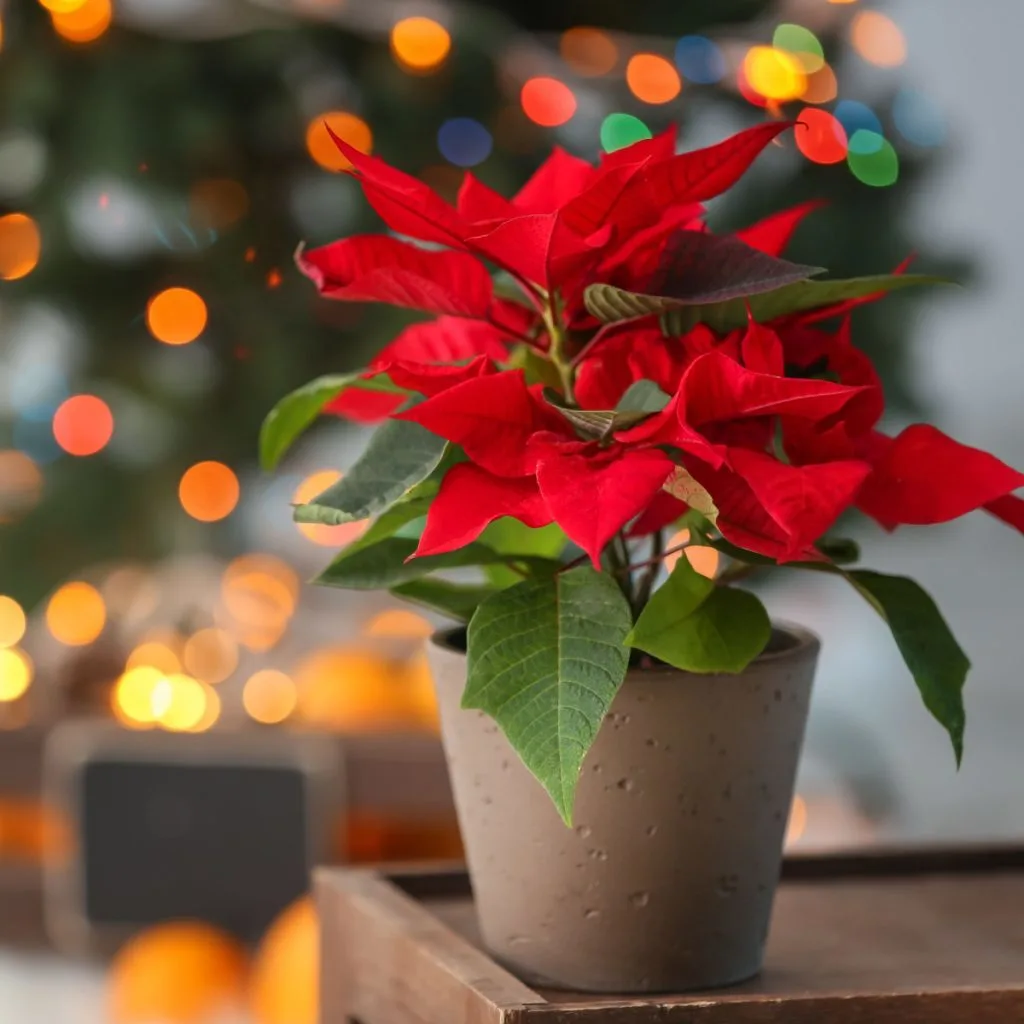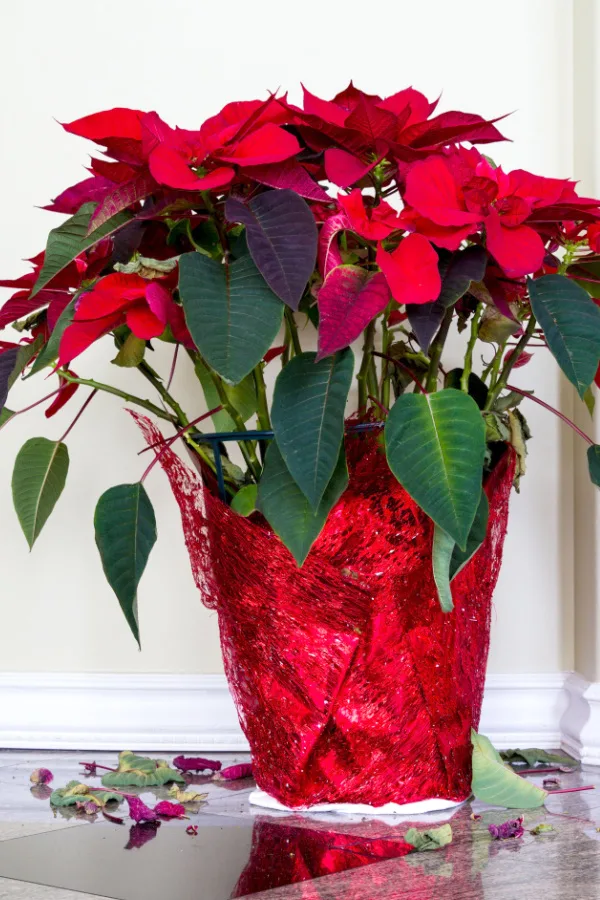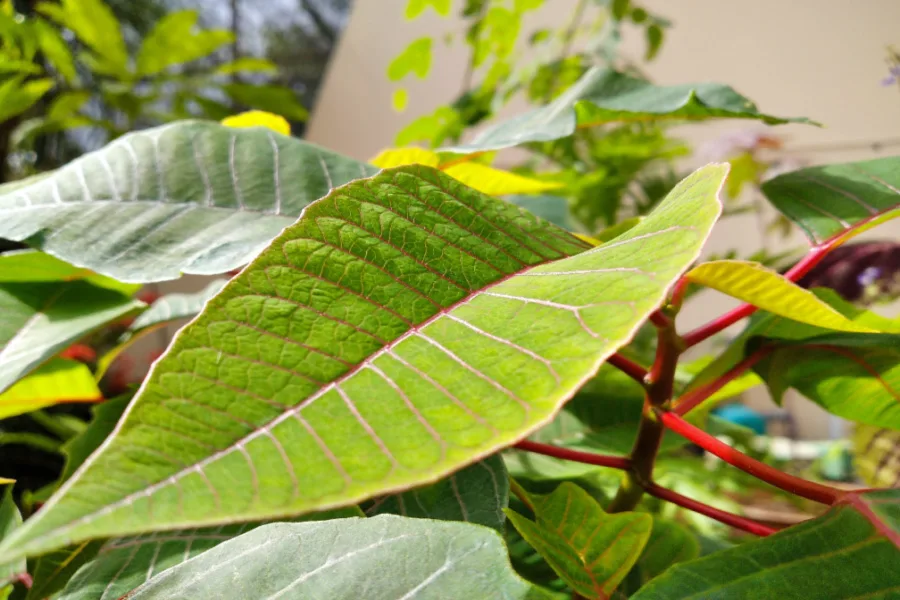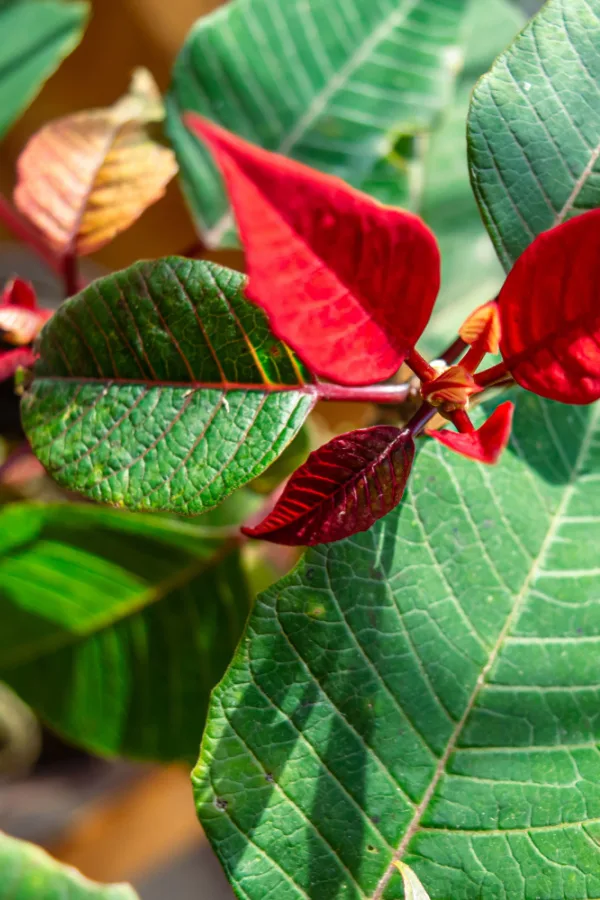Don’t throw those those dying poinsettia plant to the curb after the holiday season passes – see how to save and keep them alive and thriving as a houseplant all year long!
As the holiday season comes to a close, the gorgeous blooms of a poinsettia usually follow suit soon afterwards as well. The once vibrant plants start to drop their colorful leaves in January or February. Unfortunately, many think it’s the end of the line for the holiday blooming plants. And because of that, they sadly toss the plants to the curb.
But as it turns out, poinsettias are actually perennial plants. And with just a bit of basic care, they can be kept all year round as a beautiful houseplant. Even better, you can also get them to bloom just as bright during the holidays next year and beyond!

Poinsettia plants actually make for very attractive green foliage plants all year around. Not only can they be kept indoors, but during the spring, summer and early fall, they are more than content to hang outside next to your other seasonal potted plants.
Then, as late fall arrives once again, you can bring them indoors and prepare them for another incredible holiday display of color. The good news – keeping poinsettias alive all year long couldn’t be easier!
How To Save Dying Poinsettia Plants – Keeping Poinsettias Alive!
While they are often seen as the unofficial “flower” of the holiday season, the colorful well-known portion of poinsettias that “bloom” aren’t actually flower petals at all. The foliage that changes colors just in time for the holidays are actually called bracts.
Bracts are actually leaves that form around a small group of the plant’s flowers. It’s just that the bracts are so much bigger and more colorful than the blooms, they steal the show.
When you purchase a new poinsettia plant, garden nurseries force the plants into changing colors. This is done by exposing the plants to a period of darkness. (See, “How To Keep A Poinsettia Blooming Big”)

With proper temperatures and watering, most plants will hold their blooms well into late January. Some can even make it into February. But eventually, no matter how well cared for, the bracts die off and begin to drop.
When this occurs, the plant can begin to look quite dreadful. Which, is exactly why many think its useful life is over. But all it really needs is a little trim – and in no time at all, it will regrow into a healthy, vibrant houseplant.
Cutting Poinsettia Plants Back – How To Save Dying Poinsettia Plants
As the blooms fade and fall from the plant in large numbers, it’s time for pruning. Using a sharp pair of scissors or pruners, trim all of the stems back to within three or four inches above the soil line. If there are any green leaves below the three to four inch cutting line, you can leave them on.
One thing is for sure, at this point, your poinsettia plant will definitely not look very healthy or vibrant. This is very normal and just part of the process of the plant losing its bracts.
Once the plant is cut back, it’s time to give them a bit of healing light. To do this, place your poinsettia in a well lit room near a window. Do not put it directly in the windowsill as it can burn the new foliage. Instead, place it nearby where it can still get strong but indirect light.

Continue to water the plant as normal during this time frame. The soil should be moist but not saturated. As with most house plants, too much water is more detrimental than too little. This keeps roots from becoming water-logged, which is often the number one reason poinsettia plants don’t stay alive.
Within a few weeks, you will start to see new growth begin to appear. Your poinsettia plant is now well on its way to a full recovery!
Spring And Summer Poinsettia Care – How To Save Dying Poinsettia Plants & Keep Them Alive After The Holidays
As spring arrives, you can continue to keep poinsettia plants in a well-lit room or move them outside. To be safe, make sure if moving outdoors the temperatures will not drop below 55°(F). Many opt to place their poinsettia on a patio or under a bright covered porch. Some even plant them directly into the soil to add big interest to flowerbeds throughout the summer months.
No matter where you place your poinsettia, the key is to give your plant as much sun as possible. The more the better. Poinsettia plants will tolerate some shade, but they need full sun to really develop strong foliage.

As they grow through the spring and summer months, you will need to occasionally prune them back. By trimming plants back to around six inches a few times, it will keep them compact, bushy and strong. For best results, prune in April and again in mid-August.
Give the plants a little bit of all-purpose fertilizer at the time of each pruning. This will help the poinsettia develop strong foliage and store energy for future bracts during the holidays. (Affiliate Product Link: All-Purpose Fertilizer)
After the last pruning and application of fertilizer in August, stop fertilizing the plant. Too much after this point will result in excess foliage growth and not enough power for bracts to form. When the temperatures start to drop below 55-60º Fahrenheit, bring them back inside and place them once again by a bright window.
Getting Poinsettia Plants To “Bloom” Again – How To Save Dying Poinsettia Plants After The Holidays
For the bracts to change color, the poinsettia plant needs to go through a period of darkness. In fact, they will need about 14 hours of darkness each day for a 6-week period to form bracts.
To have the beautiful color arrive in time for Thanksgiving, start this darkening process around October 1st. If you want them in full bloom for Christmas, wait until mid to late October to start the process. If you happen to have multiple plants, you can stagger them for constant holiday color.

To provide the necessary darkness, put the poinsettia plant in a closet or completely dark area early each evening. You can also cover them with a large box or paper bag to ensure there is complete darkness. Then, bring the plants back out each morning to receive light from a window.
During this process, water your plants as normal. One of the most common causes of failure in keeping poinsettia plants alive is too much or too little water. With that in mind, stay consistent with watering for best results.
Repotting – How To Save Dying Poinsettia Plants & Keep Them Alive After The Holidays
Poinsettia plants will usually outgrow their pot within a year or two. Re-potting when they do will help to keep them healthy and allow their roots enough room for future growth. It’s best to re-pot in the early spring to allow plants plenty of time to establish good roots before the fall darkness period.
When repotting, use a high-quality potting soil and select a pot about 25% larger than your existing plant. Again, keep your plant well watered after transplanting to help the plant re-establish quickly.
Here is to keeping your poinsettia plants alive and providing you with beautiful holiday color year after year!
This Is My Garden
Follow Our Facebook Page For Great Gardening Tips And Advice! This Is My Garden Facebook Page
This Is My Garden is a garden website created by gardeners, for gardeners. Jim and Mary Competti have been writing gardening, DIY and recipe articles and books and speaking for over 15 years from their 46 acre Ohio farm. They publish three articles every week, 52 weeks a year. Sign up today to follow via email, or follow along!
